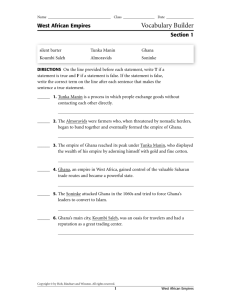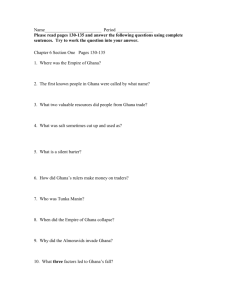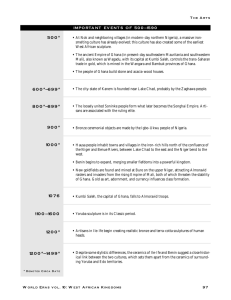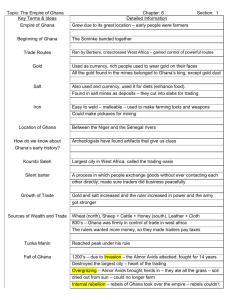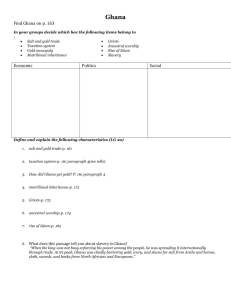Ghana Empire - WordPress.com
advertisement
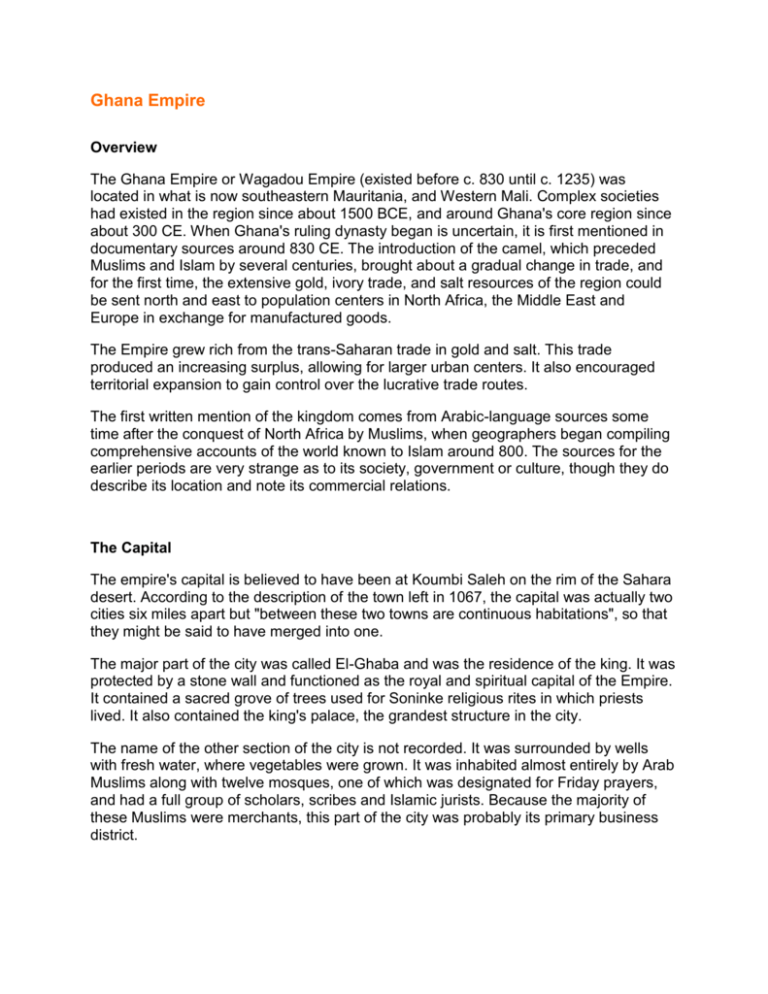
Ghana Empire Overview The Ghana Empire or Wagadou Empire (existed before c. 830 until c. 1235) was located in what is now southeastern Mauritania, and Western Mali. Complex societies had existed in the region since about 1500 BCE, and around Ghana's core region since about 300 CE. When Ghana's ruling dynasty began is uncertain, it is first mentioned in documentary sources around 830 CE. The introduction of the camel, which preceded Muslims and Islam by several centuries, brought about a gradual change in trade, and for the first time, the extensive gold, ivory trade, and salt resources of the region could be sent north and east to population centers in North Africa, the Middle East and Europe in exchange for manufactured goods. The Empire grew rich from the trans-Saharan trade in gold and salt. This trade produced an increasing surplus, allowing for larger urban centers. It also encouraged territorial expansion to gain control over the lucrative trade routes. The first written mention of the kingdom comes from Arabic-language sources some time after the conquest of North Africa by Muslims, when geographers began compiling comprehensive accounts of the world known to Islam around 800. The sources for the earlier periods are very strange as to its society, government or culture, though they do describe its location and note its commercial relations. The Capital The empire's capital is believed to have been at Koumbi Saleh on the rim of the Sahara desert. According to the description of the town left in 1067, the capital was actually two cities six miles apart but "between these two towns are continuous habitations", so that they might be said to have merged into one. The major part of the city was called El-Ghaba and was the residence of the king. It was protected by a stone wall and functioned as the royal and spiritual capital of the Empire. It contained a sacred grove of trees used for Soninke religious rites in which priests lived. It also contained the king's palace, the grandest structure in the city. The name of the other section of the city is not recorded. It was surrounded by wells with fresh water, where vegetables were grown. It was inhabited almost entirely by Arab Muslims along with twelve mosques, one of which was designated for Friday prayers, and had a full group of scholars, scribes and Islamic jurists. Because the majority of these Muslims were merchants, this part of the city was probably its primary business district. Economy Most of our information about the economy of Ghana comes from merchants, and therefore we know more about the commercial aspects of its economy, and less about the way in which the rulers and nobles may have obtained agricultural products through tribute or taxation. Merchants had to pay a one gold dinar tax on imports of salt, and two on exports of salt. Imports probably included products such as textiles, ornaments and other materials. Many of the hand-crafted leather goods found in old Morocco may also had their origins in the empire. The main centre of trade was Koumbi Saleh. The king claimed as his own all nuggets of gold, and allowed other people to have only gold dust. In addition to the exerted influence of the king onto local regions, tribute was also received from various tributary states and chiefdoms to the empire's periphery. The introduction of the camel played a key role in Soninke success as well, allowing products and goods to be transported much more efficiently across the Sahara. These factors all helped the empire remain powerful for some time, providing a rich and stable economy that was to last over several centuries. Politics Much testimony on ancient Ghana depended on how well disposed the king was to foreign travelers, from which the majority of information on the empire comes. Islamic writers often commented on the social-political stability of the empire based on the seemingly just actions and grandeur of the king. The Arabic sources, the only ones to give us any information are sufficiently vague as to how the country was governed. It is mentioned that the king had officials who surrounded his throne when he gave justice, and these included the sons of the kings of his country. Detailed accounts on the geography of the region show that in 1067 Ghana was surrounded by independent kingdoms, and Sila, one of them located on the Senegal River was "almost a match for the king of Ghana." Decline Given the scattered nature of the Arabic sources and the ambiguity of the existing archaeological record, it is difficult to determine when and how Ghana declined and fell. The earliest descriptions of the Empire are vague as to its maximum extent, Ghana had forced Awdaghast in the desert to accept its rule sometime between 970 and 1054. A tradition in historiography maintains that Ghana fell when it was sacked by the Almoravid movement in 1076, but this interpretation has been questioned. Dierk Lange, who believes that the Almoravids had an important role in Ghana's fall, notes that it was due to their instigation of internal political instability, rather than military actions or conquest. While there is no clear cut account of a sack of Ghana in the contemporary sources, the country certainly did convert to Islam. They extended their domination over the Sudan, pillaged, charged poll tax and other dues, and converted many of them to Islam. It is clear, however, that Ghana was incorporated into the Empire of Mali, according to a detailed account of al-'Umari, written around 1340. Ghana still retained its functions as a sort of kingdom within the empire, its ruler being the only one allowed to bear the title malik.
